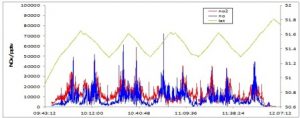Instrument Support Level 3
Air Quality Design - Bespoke instrument
Not Applicable
Calendar

AQD Fast NOx
NO measurement is based around the chemiluminescence produced when NO reacts with ozone producing an excited state NO2 molecule.
NO + O3 → NO2* + O2
NO2* + hv → NO2
This emission radiation is detected by a PMT cooled to -20oC by a chiller to reduce dark counts. Most of the chemical interferences that also produce chemiluminescence are taken into account by employing a pre-chamber in the system. This adds oxygen to the gas flow upstream of the main reaction chamber where NO completely reacts with ozone. As most interference reactions are considerably slower than the NO + O3 reaction, the PMT signal when O3 is added to the pre-chamber can be thought of as the instrument zero. A pre-chamber zero is carried out in every measurement cycle (typically 2 minute cycles but these are changeable depending on the specific use). A photolytic NO2 converter (diode based blue light converter (BLC) – Air Quality Design), which selectively converts NO2 to NO, is used to provide measurements of NO2 in a second NO chemiluminescence channel. Data is taken at 10Hz frequency, however averaging to 1second and 1 minute is carried out automatically by the data acquisition software.
The instrument is calibrated using a cylinder of 5 ppm NO in N2 (Air Liquide for aircraft use; BOC for ground use). A small flow (5sccm) is of the calibration gas is added to the sample flow (1000sccm), allowing dilution of the calibration gas to around 25 ppb and calibration at equivalent humidity to ambient air. The calibration cylinder is itself calibrated to an NPL cylinder held in the COZI laboratory in York. NO2 is calibrated using gas phase titration of the NO to NO2 upon addition of a small amount of O3.
For aircraft use, calibrations would be carried out pre-flight, twice in flight (start and end) and post flight. Data will be corrected to affect changing calibrations during the flight. For ground use, calibrations would be carried out every 36-48 hours and data corrected for any changes.
NO and NO2 data is taken at 10Hz time resolution but also averaged to 1 second and 60 seconds by the data analysis software. All three data series would be available (and further averaging on request).
Field Data
- The instrument produces a range of out files and all are text format.
- The user can download (but not delete) this data from the instrument but it should be noted that this data will not have been quality controlled.

Example of 10Hz NO and NO2 data.
Archive Data
- Data is provided in NetCDF files following the AMOF data standard
- Files contain no more than 24hr of data.
- Instrument name is
- ncas-fast-nox-1
- The data product(s) associated with this instrument:
- Example data file
